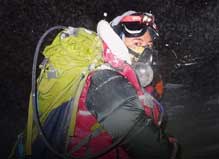The Winter Spine Race
Named after its venue – the “Backbone of England” – the Winter Spine Race follows the Pennine Way from Edale to Kirk Yetholm. Participants have seven days to complete the 268 mile course, carrying their shelter, sleeping bags, clothing, food, cooking kit, etc. with them. The route takes in windswept moorland, wet bogs, steep rocks, forest and more besides, and as it’s in the middle of winter in the Pennines, there’s ice, snow, biting winds and horizontal rain to deal with too.
There is a shorter version, but 108 miles of Pennine winter in 60 hours means the Spine Challenger isn’t an ‘easy’ option, as such.
Winter Spine Race Sleeping Bags
 The Winter Spine kit list recommends a bag suitable for “Sub Zero/0°C”. Of our down bags, the M.Degree° series really is the most obvious choice. These specialist race-developed bags are the lightest of the light, with the M.Degree° 250K rated at 0°C, the M.Degree° 300K providing warmth down to -3°C, and the M.Degree° 400K down to -9°C for those who really feel the cold. As well as these more recently developed bags, the Minim 400K (-5°C) has proved itself well in the past, and would still be a good choice for those wanting a more 'general purpose' backpacking and camping bag which also lends itself well to the Winter Spine.
The Winter Spine kit list recommends a bag suitable for “Sub Zero/0°C”. Of our down bags, the M.Degree° series really is the most obvious choice. These specialist race-developed bags are the lightest of the light, with the M.Degree° 250K rated at 0°C, the M.Degree° 300K providing warmth down to -3°C, and the M.Degree° 400K down to -9°C for those who really feel the cold. As well as these more recently developed bags, the Minim 400K (-5°C) has proved itself well in the past, and would still be a good choice for those wanting a more 'general purpose' backpacking and camping bag which also lends itself well to the Winter Spine.
The basic figures for recommended sleeping bags:
| S-bag | TOT (Min Temp) | Weight | Packed size Hght x Diam (cm) |
||
|---|---|---|---|---|---|
| C | F | gm | oz | ||
| Minim 400 | -5 | 23 | 670 | 24 | 28 x 17 |
| Minim 400 K | -5 | 23 | 585 | 21 | 28 x 17 |
| M.Degree° 250K | 0 | 32 | 390 | 14 | 21 x 13 |
| M.Degree° 300K | -3 | 27 | 445 | 16 | 21 x 13 |
| M.Degree° 400K | -9 | 16 | 550 | 20 | 21 x 13 |
Additional points:
- TEMPERATURE RATING: Put simply, these are the temperatures at which you should be able to get a night's sleep in normal circumstances. For fuller details about the TOT rating see this Technical Briefing.
- LINERS: A liner will add to the insulation, but as always there is a trade-off between the extra weight and bulk, and the warmth you gain. Silk liners add roughly 2°C but only weigh around 140g so they’re a popular choice. If you’re particularly concerned about cold, our K Series Filler Bag is 100g heavier than that but will add 10°C.
- CLOTHING: Thermal baselayers obviously help to keep you warm, and lightweight warm layers such as our Sigma clothing boost the performance of the bag considerably. See the Clothing section below for more details.
- FABRIC OPTIONS: The M.Degree K bags come with 7X (our lightest fabric) as standard and the Minim 400K comes with MX. However, for damp winter racing, we’d recommend that you choose the Ultrashell/Hypershell options. These fabrics are highly wind/water resistant but do not add significantly to the weight of the bags: Ultrashell adds about 18g, Hypershell adds 15g.
- ZIPS: The Minim and M.Degree° bags do not have zips as standard. Zips are an option, but most competitors don't ask for one. A short zip with draft tube adds about 50g (2oz): a full zip and tube adds about 110g (4oz). Zips also add to the packed size. The Zeta has twin zips for the particular demands of Alpine bivis, but is available with a side zip or, like the others, no zip at all.
- PACKED SIZE: PHD stuff sacs tend to be on the loose side. All these bags can be compressed further in your pack.
Winter Spine Race Clothing selection
Racers obviously generate a lot of body heat when moving, so the contrast when they stop for the night in the middle of winter is quite marked, making warm, lightweight, compressible clothing a must.
It’s worth considering synthetic options such as the Sigma Jacket. Although a little heavier and bulkier than down, their advantage is that synthetics outperform down in the wet. As well as coping better with wet weather, this also means they’re suitable for wearing while running.
Down clothing is smaller and lighter, however, and our Ultralight range of clothing was designed to meet the need for ultimate weight/space saving. The Ultra Pullover K will provide real warmth down to about -5C. At 195g it's about half the weight and bulk of a conventional fleece jacket and 100% windproof as well. Lighter still is the Wafer range, in particular the extremely light Wafer Ultima pullover. Warm down to freezing point but weighing in at just 155g it's lighter than most T-shirts.
Both options – down and synthetic – will increase the performance of a sleeping bag, whether it’s a top for a boost of core warmth, or as part of a head-to-toe Sleep System. Cold feet can interrupt even the most exhausted of sleepers; Wafer Socks weigh just 45g but can make a significant difference!
The next Winter Spine Race will start on 12 January 2025:
Photo: simonsimages




















